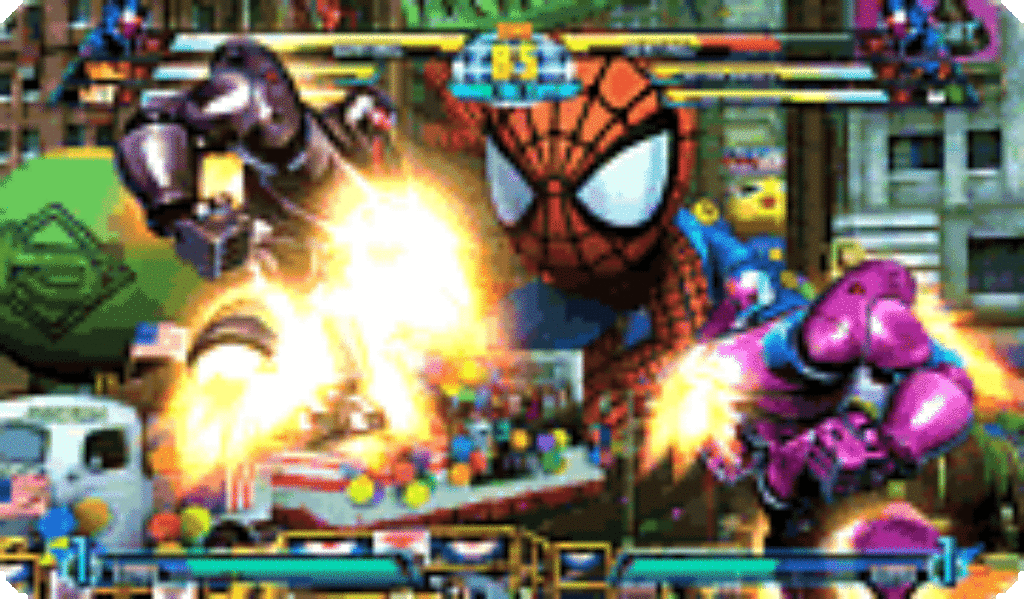
It doesn’t take a rocket scientist to see how video games and comic books might appeal to the same audience. And video game titan Capcom leveraged that observation to the max in 1998, with the release of its game Marvel vs. Capcom: Clash of Superheroes.
The arcade version (followed by ports for Sony’s PlayStation and Sega’s Dreamcast consoles) plopped players into the spandex of classic Marvel Comics heroes (and villains) as they went head-to-head against an array of characters from Capcom’s popular games, the Street Fighter titles chief among them. A sequel soon followed (Marvel vs. Capcom: New Age of Heroes).
It was arguably the high-water mark for a genre that, despite its all-combat-all-the-time orientation, was steadily losing ground to the fast-growing popularity of shooters. So fast-forward 11 years, and Capcom has decided that the hard-core fans of the series (who, remarkably, are still playing a game more than a decade old in tournaments!) deserved an update.
From Mashing to Mastery
Update, of course, doesn’t mean brand new. And the template—firmly established by the Street Fighter franchise back in the 1990s—is pretty simple: Characters face off against each other horizontally, unleashing all manner of martial arts, melee maneuvers and special powers in an attempt to knock everybody else out.
In MvC3, Capcom has amped everything up to such insane levels of frenetic, attention-deficit-creating craziness that it makes just about any other form of entertainment you can think of feel like swimming in a tar pit. Whether playing online against remote opponents or offline against the AI, players choose three warriors from among 36 (counting some that have to be downloaded) on the Marvel and Capcom rosters.
On the Marvel side, available heroes and villains include household names such as Spider-Man, Wolverine, Captain America and Magneto, along with more obscure folks such as Shuma-Goratha, M.O.D.O.K. and X-23. Representing Capcom are Street Fighter vets Ryu, Chun-Li, Crimson Viper and Akuma, as well as Darkstalkers’ Morrigan Aensland, Resident Evil’s Albert Wesker and Chris Redfield, and Devil May Cry‘s Dante and Trish. Note: Despite what the game’s title suggests, you can freely mix and match characters from both sides on your team.
Then the button mashing begins. And I do mean button mashing.
MvC3 is the first game I’ve played in a long time that left me feeling like I might have an asthma attack and develop carpal tunnel syndrome right now! I played my fair share of Street Fighter games back in the day, but the explosive, frantic nature of gameplay here feels like someone jumped repeatedly on the fast-motion button. Up to two of your three characters can engage in combat at any time. Rounds last but a few minutes, with one team emerging victorious to taunt the other.
I didn’t bother to read the instructions—I just started pushing buttons as wildly as I possibly could after sliding the disc in. In just a few minutes, I intuitively sorted out how to switch the main character I wanted fighting, as well as how to call in a secondary attack from one of my team members on the sideline. And, as long as I kept mashing those buttons like mad, I mostly kept winning.
In this sense, Capcom’s latest fighter feels more accessible to novices. But once players get past what I might euphemistically call the game’s initial “Hulk SMASH” stage, you’ve got to hone those combat skills by investing a whole lot more time investigating the intricacies.
Sensual Spirituality
And that adds up to a whole lot more exposure to some of MvC3′s less than healthy imagery and messages.
You might think the main concern with a fighting game like this one would be its onscreen violence. And while there’s plenty of that, the contest feels more like an old-fashioned comic book than a level of Mortal Kombat. There’s no blood or gore, for one thing. And when defeated opponents are knocked out, they simply disappear, arcade style. Perhaps the most gruesome violence, then, happens when certain characters set others (briefly) on fire.
But there are other problem areas. Nearly all the female characters wear skintight uniforms over their exaggerated figures. But in some cases, we get more form than uniform. Take Morrigan, for instance. Her top—and it’s a Herculean feat of exaggeration to label it that—barely even bothers to extend to her enormous breasts.
And Morrigan knows it, too. When one team wins, the final character fighting on the victorious side gets to lob a taunt at the losers. Morrigan’s is, “I’m so glad that you wanted to take us on. But you didn’t have what it takes to satisfy me.”
Players digging deeper into the game’s features will find a 3-D gallery of every character—not good in the case of someone like Morrigan—as well as a brief backstory. Morrigan’s informs us, “She is a succubus, a demonic creature able to seduce men. She is well known for her voluptuous figure and her titillating clothing. Although she is head of the Aensland house, one of the three major houses of the demon world, she often abandons her dull duties to go looking for excitement.”
Occult references don’t end there. A fire-headed entity known as Dormammu quips, “Your crude understanding of the rudimentary black arts is infantile.” Elsewhere the game says of him, “All those who are connected to the dark arts are gathered and ready to serve you.”
Factor in some mild profanity (“a‑‑,” “d‑‑n,” “h‑‑‑”) and I had no choice but to take off, throw down and grind to bits the rose-colored glasses I was wearing when I first started my trip down the Capcom and Marvel memory lane.

After serving as an associate editor at NavPress’ Discipleship Journal and consulting editor for Current Thoughts and Trends, Adam now oversees the editing and publishing of Plugged In’s reviews as the site’s director. He and his wife, Jennifer, have three children. In their free time, the Holzes enjoy playing games, a variety of musical instruments, swimming and … watching movies.